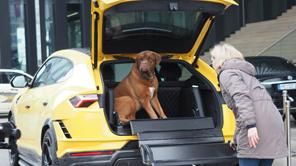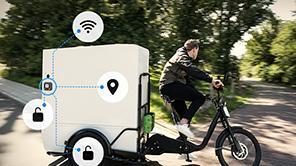UL & Southco: UL Recognized Access Hardware Saves Enclosure Manufacturers Testing Time

Introduction
UL is recognized worldwide for helping companies demonstrate safety, confirm compliance, deliver quality and performance and build workplace excellence through services such as: inspection, advisory services, education and training, testing, auditing and analytics, certification and marketing claim verification.
UL recently released FTTA2/FTTA8, a new Recognition Certification for the US and Canada. This new Recognition Certification for enclosure accessories assists manufacturers who wish to utilize Type rated hinging and latching accessories in enclosures complying with the requirements of UL 50E. Southco, Inc., a key supplier of enclosure accessories, recently collaborated with UL to complete testing and Recognition Certification of a select portfolio of its hinge and latch products according to FTTA2/FTTA8.
The Challenge
UL 50 and UL 50E are two UL Standards for electrical enclosures. UL 50 applies to enclosures for electrical equipment intended to be installed and used in non- hazardous locations in accordance with the Canadian Electrical Code, Part I, CSA C22.1, the provisions of the National Electrical Code, NFPA 70 and the provisions of Mexico's Electrical Installations. UL 50 is a tri-national standard harmonized with CSA C22.2 No. 94.1-07 and NMX-J-235/1–ANCE-2007. UL 50E covers additional environmental construction and performance requirements for these types of enclosures.
If component products do not comply with UL 50 and/or UL 50E, the entire enclosure needs to be refitted and tested again, which can lead to a continuous loop of cost and testing time. To illustrate the cumulative impact of this loop, it can add up to 50 days or more to the timeline for completing one FTTA2/FTTA8 corrosion test – a major disruption of a manufacturer’s development plans.
Testing can range in complexity, and manufacturers may not have the equipment needed to test under certain environments, or may not have the manpower to perform these tests. Ultimately, this type of testing can exhaust the resources of the enclosure manufacturer and extend their end product’s time to market.
The Implementation
Southco has submitted select product classes to UL for testing and investigation under FTTA2/FTTA8, to evaluate these components’ resistance to corrosion and performance degradation due to environmental conditions and usage over time. These product classes included the E5 Cam Latch and E3 VISE ACTION® Compression Latch series, TL and V7 Draw Latch series, ST Constant Torque Positioning Hinges and M3 Multi-Point Compression Latching System, spanning over 100k product configurations based on finishes, materials and panel preps.
According to UL representative John Kovacik, Principal Engineer, a company like Southco that is seeking Recognition Certification for its products will be required to submit a range of products from the family of products to be evaluated. “We select certain samples from the products that are submitted by Southco or any manufacturer interested in obtaining this coverage,” he said. “We would select samples that were representative of a family. For example, if they were submitting different kinds of latches and there were many that Southco wanted covered, we would select samples that if we tested and found acceptable, would then give them coverage for the entire line of latches.”
Understanding FTTA2/FTTA8
To understand FTTA2/FTTA8, it is useful to understand how UL evaluates and certifies components according to UL standards. A complete product is ultimately an assembly of components, often thought of as building blocks. Components can be either Listed or Recognized by UL. The simplest method by which to comply, on a component level, is to start with certified components.
With UL’s component recognition service, UL determines that a manufacturer has demonstrated the ability to produce a component for use in an end product that complies with UL’s requirements. This type of investigation takes into account the performance and construction characteristics of the end product and how the component will be used in that product.
The new FTTA2/FTTA8 Recognition Certification covers a broad range of enclosure accessories, including:
-
3-point handles
Butt and concealed hinges
Draw latches and compression latches
Captive fasteners
Quarter-turn fasteners
Swinghandles
UL conducted three highly rigorous environmental exposure tests to assess the samples selected from the hinges, latches and other products submitted.
• 50 day/1200-hour moist carbon dioxide (CO2)/sulphur dioxide (SO2) air test
The test simulates a long-term exposure to the environment for a particular material, which corresponds to simulating a 20 to 30-year lifecycle of the product. Once the exposure
is completed, samples are evaluated by performing a visual inspection to identify certain levels of corrosion and pitting. A blister analysis and creepage analysis is also performed.
• 25 day/600-hour salt spray test
The test benchmarks the test sample against G90 galvanized sheet steel. Passing both the 600-hour and the 1200-hour test is required to achieve a UL 50E Type Rating suitable for outdoor applications.
• 200-hour salt spray test
The test sample is compared with standard 304 series stainless steel to assess that zero pitting, cracking, bubbling or scaling has occurred during exposure. Passing all three tests earns an extra degree of corrosion resistance, designated by an “X” in the Type Rating (e.g., 3RX, 4X).
UL also conducted testing on flange gaskets and O-rings which are critical components contributing to the sealing features of latches and fasteners. Naturally, the gasket swelling, shrinking or losing its elasticity may be a problem. To rule this out, oil immersion at room temperature as well as tensile strength and elongation tests are performed before and after oven aging to evaluate gasket materials and their ability to provide secure latching over a long period of use and exposure to environmental conditions.
The Results
Enclosure accessories that pass these tests and receive the FTTA2/FTTA8 Recognition Certification can be used by manufacturers who create or use Type rated enclosures that comply with UL 50 and UL 50E, which streamlines the process of bringing Type rated enclosures to market.
For example: Type 4X rated enclosures are certified for outdoor use, providing an established degree of protection against hosedown, splashing water, windblown dust, rain, snow and sleet, and are constructed of materials and components that remain undamaged by the formation of ice on the enclosure.
So, if all the other Type 4X conditions are met -- constructing the enclosure out of materials exempt from corrosion testing such 304 or 316 stainless steel, using pre-qualified UL approved gaskets to line the enclosure, and choosing accessories with the new FTTA2/FTTA8 recognition, like Southco’s E3 Compression latch series – all enclosure manufacturers will need to do is perform a hosedown test to document that their enclosure can be Type 4X rated by UL.
By pre-qualifying the enclosure for outdoor applications, it’s been estimated the manufacturer will save at least 50 days of testing time as well as the cost of test samples.
The Conclusion
Using components that already comply with FTTA2/FTTA8 provides added peace of mind to the manufacturer’s end customer, in that the functionality of that enclosure will not be affected when used by operators in the field.
Working with an accessories supplier that understands compliance requirements, and has proven experience in meeting the core functional needs of the application can help ensure that the design is successful; for example, suppliers can help manufacturers avoid future testing and design issues.
It is important to note that selecting accessories with FTTA2/FTTA8 Recognition does not mean the enclosure manufacturer can bypass final testing of a completed enclosure. It simply means that the accessories themselves do not require additional testing. The manufacturer must still work with UL to complete the required testing of the enclosure as a whole under UL 50/50E.
“UL works with manufacturers from the outset to help them address challenges and achieve compliance,” said John Kovacik, Principal Engineer, UL. “Not only do we excel in research and science, but we understand our customers’ market needs. So, we are uniquely skilled to help them with testing, certification, analysis of the results and explain, if needed, why there is a failure, in order to help them revise and retest.”
Selecting UL-Recognized Southco products can ultimately save significant design, testing and certification costs, enabling faster market access for new enclosure designs that satisfy end-user requirements for Type rated applications.



